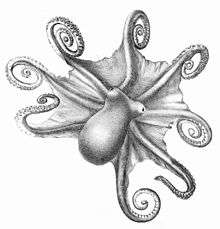Benthoctopus levis
| Benthoctopus levis | |
|---|---|
 | |
| Scientific classification | |
| Kingdom: | Animalia |
| Phylum: | Mollusca |
| Class: | Cephalopoda |
| Order: | Octopoda |
| Family: | Octopodidae |
| Genus: | Benthoctopus |
| Species: | B. levis |
| Binomial name | |
| Benthoctopus levis (Hoyle, 1885) | |
| Synonyms | |
| |
Benthoctopus levis is a species of octopus in the Octopodidae family.[1] It was first described by William Evans Hoyle in 1885 in an article in the Annals and Magazine of Natural History detailing the new species of octopus found on the HMS Challenger as part of the Challenger expedition; the type specimen was retrieved from the Southern Ocean.[2] The species is found in subantarctic waters[3] in the Southern Ocean, particularly surrounding Heard Island and Kerguelen Island,[2] but specimens comparable to B. levis have also been found at the Antarctic Peninsula.[4]
It is known to inhabit shallow depths of between 21 and 404 metres (69 and 1,325 ft).[5] It is predatory, living and feeding in the benthic zone,[2] where it feeds heavily on brittle stars. In a study in which the stomach contents of 70 specimens were examined, around 50 were shown to have fed only on brittle stars.[6] A study on the reproductive strategies of coleoid cephalopods concluded that while "a simultaneous terminal spawning strategy is most likely" for B. levis, "the egg-length frequency graphs and multivariate analysis also suggest a greater variation in egg-lengths which could lead to spawning over an extended period".[7] The study collected five female B. levis specimens from the Southern Ocean. They weighed from 16 to 219 grams (0.56 to 7.72 oz) and the mantle length was from 34 to 58 millimetres (1.3 to 2.3 in).[7]
B. levis is similar in appearance to another species in the same genus, Benthoctopus rigbyae. B. rigbyae was first described in 2009 based on specimens found in Antarctic trawling surveys near the Antarctic Peninsula, and, while similar in appearance, differs from B. levis in its arm length, the depth of its interdigital webbing and specific details of its hectocotylus.[3] Further, the species is found in slightly deeper waters, having been recorded at depths of between 250 and 600 metres (820 and 1,970 ft).[5]

References
- ↑ Jacob van der Land (2009). Benthoctopus levis (Hoyle, 1885). The World Register of Marine Species. Accessed on 22 August 2010.
- 1 2 3 K. L. Lamprell; A. M. Scheltema; J. M. Healy (2001). Zoological Catalogue of Australia: Mollusca, Aplacophora, Polyplacophora, Scaphopoda, Cephalopoda. Csiro Publishing. p. 158. ISBN 978-0-643-06707-3.
- 1 2 Michael Vecchione; Louise Allcock; Uwe Piatkowski; Jan Strugnell (2009). "Benthoctopus rigbyae, n. sp., A New Species of Cephalopod (Octopoda; Incirrata) from Near the Antarctic Peninsula". Malacologia. 15 (1): 13–28. doi:10.4002/040.051.0102.
- ↑ Alan J. Southward; Craig M. Young; Lee A. Fuiman (2006). Advances in Marine Biology, Volume 50. Academic Press. p. 207.
- 1 2 J.M. Strugnella; Y. Cherelc; I.R. Cookeb; I.G. Gleadalle; F.G. Hochbergf; C.M. Ibáñezg; E. Jorgensenh; V.V. Laptikhovskyi; K. Linsej; M. Normank; M. Vecchionel; J.R. Voightm; A.L. Allcockn (2010). "The Southern Ocean: Source and sink?". Deep-Sea Research. Elsevier. 58: 196–204. doi:10.1016/j.dsr2.2010.05.015.
- ↑ Roger T. Hanlon; John B. Messenger (1998). Cephalopod Behaviour. Cambridge University Press. p. 60. ISBN 978-0-521-64583-6.
- 1 2 I. Barratt; M. Johnson; A. Allcock (2007). "Fecundity and reproductive strategies in deep-sea incirrate octopuses (Cephalopoda: Octopoda)". Marine Biology. 150 (3): 387–398. doi:10.1007/s00227-006-0365-6.